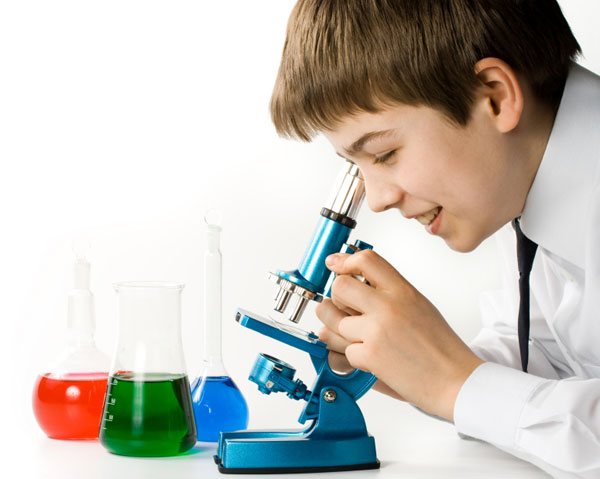
First things first...
Before you launch into the world of science with your kids, do some prep to make sure that they not only have fun, but possibly learn a little along the way too! Pick up some of those classic black and white covered composition books that make the perfect "lab books" for your kids to predict what will happen, draw pictures of each step of the experiment and record their observations.
Don't forget about safety! Even the simplest of experiments can quickly turn dangerous when kids are involved! Be extra cautious if you're doing experiments that involve heat and remind them that, no matter how excited they get, only Mom or Dad are allowed to touch and move hot items safely. Goggles would also be a great idea and your kids are probably still young enough to think they're pretty cool.
Lastly, prep your house for your experiments before you even get your kids involved. Put away anything breakable, lay down plastic or newspaper on surfaces that could get wet or ruined and make sure you've done all the dishes so that you can easily dump things in the kitchen sink afterwards. And, if all else fails, move the experiment into the garage or backyard where messes hardly matter!
Grow a little something
The simplest of science experiments for kids can come straight from your refrigerator or pantry and although the results aren't immediate, it is a fun way to introduce your kids to science. Start with whatever seeds you may have in your house — from the pit of an avocado to a few leftover lima beans to the seeds from the apple that you just cut up for lunch. It's most fun if you get a few types of seeds going at the same time, so that your kids can compare the ways that they grow with each other. For avocado pits, place toothpicks in the fat part of the pit so that you can suspend it in a jar, glass or vase of water, with the water coming about half way up the pit. Put it on your windowsill and let it be, checking it each day to make sure there is enough water. Eventually, your kids will be rewarded with stems that start to shoot out the bottom of the pit, into the water!
For other seeds, the classic method of wrapping the seeds in a paper towel soaked with warm water and putting them in a sealed plastic bag will always be the quickest and easiest way to get them growing. Leave them for a solid 24 hours before you start checking them, or leave the paper towel underneath the seeds, so that you can easily see them grow through the bag.
Did your kids love this experiment? Try taking it to the next level with how to grow seeds indoors>>
Where science meets pretty
The next time you're picking up some blooms to brighten up your home, grab a bunch of white carnations while you're at it! We have no idea if carnations are the hottest new trend in home floral decor, but we do know that they can go a long way for some simple science fun. Grab a bunch of glasses and fill them with water — one for each bloom in your bunch, giving them a fresh cut at the bottom of the stem first. Then, start experimenting with some colors, using food coloring. Do the basics that you have in your food coloring pack — straight into the glasses of water — and also use it as a chance to mix some secondary colors . Once every glass of water has a color, sit back and watch. It won't be long before the stems of the flowers start to suck up the colored water, turning each bloom a new, colorful hue! And, don't forget to pull out those lab books — this is the perfect chance to draw some pretty observation pictures!
Like oil and water
We all know the old water and oil experiment, right? Fill a plastic water bottle with cooking oil and water — a half-and-half ratio works great — leaving room at the top of the bottle. Your kids will notice right away that the two liquids separate from each other . Then, take it to the next level by adding some food coloring and seeing what happens . And, shake it all up for a few minutes — make sure the lid is on tight first — and watch it all settle back again. Lastly, once the oil and water have fully separated again, put the entire bottle in the freezer for a few hours and see what changes have occurred. Your kids will be shocked to see that the water, now frozen, is at the top of the bottle and the oil at the bottom!
More on kid activities
9 At-home activities for sick kids
10 Outdoor winter activities for kids
How to help your kid hone an extracurricular activity